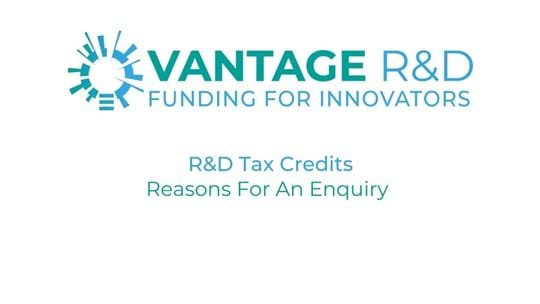Why have you been picked for an enquiry?
The reasons for the enquiry are not always disclosed by HMRC, but it could be due to an error in the CT600, the calculation of the claim is not clear or detailed, or the technical report does not clearly identify the advance and technical uncertainties. A very large value first time claim may also merit an enquiry, or the industry sector would not seem to make it a viable candidate. Ultimately, if you have been robust and diligent in preparing the claim you should not worry, but a poorly prepared claim can lead to penalties due to negligence or worse, if it is deemed deliberate, tax evasion.
How long does an enquiry last?
If your claim is selected for an enquiry, our expert team are here to guide you through the process at no extra cost.
An enquiry can start off as a simple query on one item, which if satisfactorily answered should not delay the claim too long, generally between 2 – 4 weeks. The other end of the scale is a full compliance check which can be an intensive process and could last six months or more.
For the purposes of this series of videos, we will relate what HMRC expect to see in relation to the technical activity and the respective qualifying costs.
How should you calculate employee costs?
Employees fall into one of the following groups: 1) Directly qualifying activity or 2) Indirect qualifying activity. For example, an engineer designing and drawing a new component and creating a CNC cutting path would be direct, whereas the operator of the machine making the component would be indirect. It is quite common for claims to omit indirect activities.
For new claims, the allocation of employee time is generally apportioned retrospectively, but if you have been claiming for 3 or more years, you should be keeping records of their time for R&D. As for apportionment, HMRC will certainly notice if you have allocated all staff at 100%!
If your employees are claiming expenses, which in some cases is allowable, HMRC may want to see what they were and proof of payment to said employees.
How should you calculate subcontractor costs?
If you have engaged a separate entity to carry out your R&D for you, that is a necessary part of the wider project, then you can claim subcontractor costs. If the company is not connected to you, then you can claim 65% of costs, or if they are connected, 100%.
The danger usually lies in the use of subcontracted services, which may not be claimed. An example would be the use of welding services for a component that is a key part of the R&D project. The R&D is deemed to start after the component has been returned and is therefore not an eligible claim cost.
How should you calculate EPW costs?
EPWs are pseudo-employees, such as agency workers or employees from another company that are supplied to you, but paid by a third party.
There must be some evidence of PAYE from the limited company that the EPW works for. If the individual is self-employed then the cost is not eligible.
The expenses of the individual can be included in the claim as long as they have been reimbursed back to the employee. If evidence can't be supplied then these costs should not be included in the claim.
Checking the eligibility of an EPW is something that we include as a standard part of our service.
Consumables Costs
Consumables are defined as items that have been consumed or transformed during the process of the R&D activity. This can include raw materials, individual components, electricity, heat and light.
There are often misunderstandings around consumables and subcontracted costs. During the claim process we will help you to understand this and make sure that costs are allocated correctly. If the component has been designed by you and manufactured by someone else, it is classed as a consumable. If it has been designed and manufactured by a third party, then this is subcontracted and doesn't qualify.
Understanding Qualifying Activity
HMRC needs to see evidence that the R&D activity you're claiming for was seeking a technological advance and that you had to undergo significant technical uncertainty to achieve the advance. A technical advance is normally described as something that is not readily deducible by a competent professional i.e. not considered to be "business-as-usual".
We often come across examples of activities that are deemed to be qualifying by the client, but after investigation we discover that these were merely challenging activities that don't represent a technical advance. As part of our due diligence, we do have to remove these from the claim.
Preparing Financial Data
When HMRC look at the financial part of the claim they will want to quickly understand what the costs are and whether they have been correctly calculated. Incorrect or unclear calculations are the ones that will tend to raise a red flag and trigger an enquiry.
Our experts are here to help you understand which costs qualify and will ensure that each of the employee, subcontractor, EPW, utility and software costs are correctly calculated and presented in a clear and concise way.







